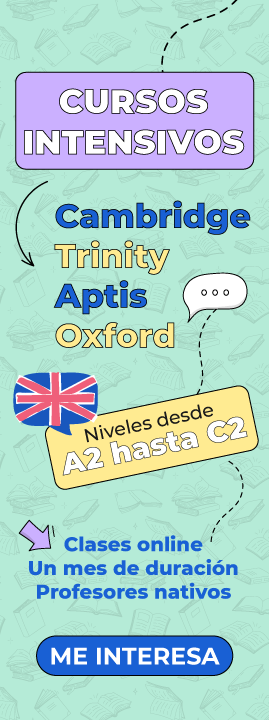Present continuous in English

The present continuous tense is formed with the subject plus the present particle form (-ing) of the main verb and the present continuous tense of the verb to be: am, is, are. A simple example of this time is: He is swimming. Some other forms of this tense are: I am singing at church today.
ÍNDICE DE CONTENIDOS
The Present Continuous is basic in English to be able to begin to gain confidence in oneself since it is the easiest verb tense used in the English language. It is used to describe actions that are happening at the same time that one speaks or cyclical situations that occur in a defined period of time.
Just as basic is not forgetting the importance of certifying your English, in Examenexam they explain everything to you!
Present continuous forms
Let’s learn the present continuous forms including the affirmative, negative, question, and short forms. There are also many examples to help make everything very clear. Before we begin, keep in mind that it is also often called present progressive
The present continuous is formed with the verb TO BE as an auxiliary and the gerund form of the corresponding verb. That is, if you detect that in the sentence there is a verb ending in -ING, it will be a continuous form. And if the verb To be is conjugated in the present, it is the present continuous
Affirmative form
| I am pointing. | Yo estoy señalando. |
| You are pointing. | Tú estás señalando. |
| He is pointing. | Él está señalando. |
| She is pointing. | Ella está señalando. |
| It is pointing. | está señalando. |
| We are pointing. | estamos señalando. |
| You are pointing. | Estáis señalando. |
| They are pointing. | Ellos están señalando |
Negative form
| I’m not pointing. | Yo no estoy señalando. |
| You aren’t pointing. | Tú no estás señalando. |
| He isn’t pointing. | Él no está señalando. |
| She isn’t pointing. | Ella no está señalando. |
| It isn’t pointing. | Cosa no está señalando. |
| We aren’t pointing. | No estamos señalando. |
| You aren’t pointing. | No estáis señalando. |
| They aren’t pointing | No están señalando. |
Interrogative form
| Am I pointing? | ¿Estoy yo señalando? |
| Are you pointing? | ¿Estás tú señalando? |
| Is he pointing? | ¿Está él señalando? |
| Is she pointing? | ¿Está ella señalando? |
| Is it pointing? | ¿Está señalando? |
| Are we pointing? | ¿Estamos señalando? |
| Are you pointing? | ¿Estáis señalando? |
| Are they pointing? | ¿Están señalando? |
For actions that are happening at the moment
- Now, I am learning English.
Ahora, estoy aprendiendo inglés.
To talk about something that is happening in the present, but not necessarily at the moment in which we speak
- This year, I’m not going on holiday.
Este año, no voy a ir de vacaciones.
For actions in a scheduled future
- They are taking piano lessons next year.
Ellos darán lecciones de piano el año que viene.
Questions in present continuous
- Am I bothering you?
¿Te estoy molestando?
- Is he listening to me?
¿Me está escuchando?
- Are we leaving already?
¿Nos vamos ya?
How to answer questions in the present continuous?
In the same way, questions in the present continuous will use this structure, starting with YES or NO, followed by the subject and then the verb to be (am/are / is). For negative answers, simply add NOT to the end of the answers. In fact, you will realize how useful this way of answering is
What is the difference between Present Simple / Present Continuous and how to use them?
We use the present simple when we want to talk about fixed habits or routines, things that do not change. We use the present continuous to talk about actions that are happening in the present moment, but that will soon end.
Compare these two statements:
- (P. simple) I play tennis. Juego al tenis.
- (Present continuous / progressive) I am playing tennis. Estoy jugando al tenis.
- (P.simple) I play tennis“Yo juego al tenis” tells us that playing tennis is something that the speaker always does. It is part of a routine or habit. We can call this a permanent situation.
- (Present continuous / progressive) I am playing tennis “Estoy jugando al tenis” tells us that the speaker is playing tennis at the moment. Soon the game will end. We call this a temporary situation.
Use of the present continuous
The present progressive is used for events that are occurring at or around this particular moment in time or to indicate that something is temporary, to talk about changing situations, and also to talk about plans for the future.
Verbs that are not used in the present continuous
There are a series of verbs that cannot normally be used in the Present Continuous, except on exceptional occasions:
- Verbs that express sensations , such as feel (sentir), hear (oír), see (ver) o smell (oler).
- They express possession, such as belong (pertenecer), own (ser propietario de) o possess (poseer).
- Verbs that express feelings or emotions , such as desire (anhelar), detest (detestar), dislike (disgustar), fear (temer), hate (odiar), like (gustar), love (amar), respect (respetar), want (querer) o wish (desear).
- Verbos que expresan actividades mentales, como agree (estar de acuerdo), believe (creer), forget (olvidar), know (saber), recognize (reconocer), remember (recordar), suppose (suponer), think (pensar) o understand (entender).
Conclusion
By way of conclusion, we can say that the present continuous or progressive is the time used to express situations that are happening now (before, during, and after the moment of speaking). When expressed in its negative form, the verb denies that something is happening now.



